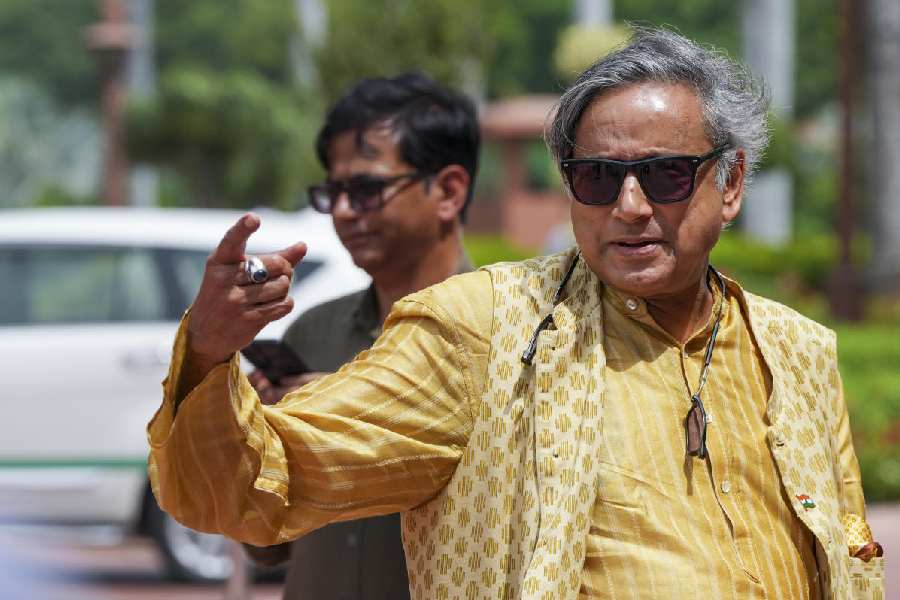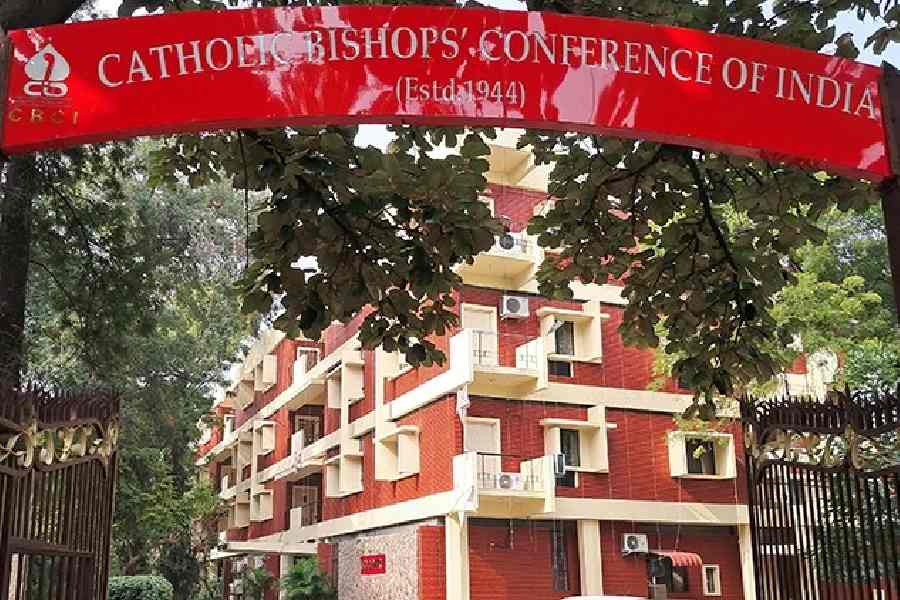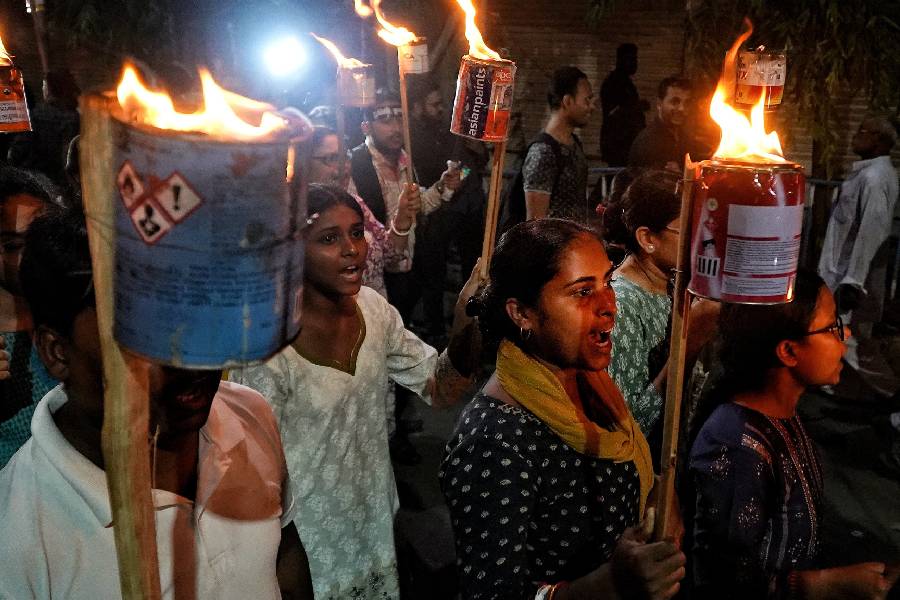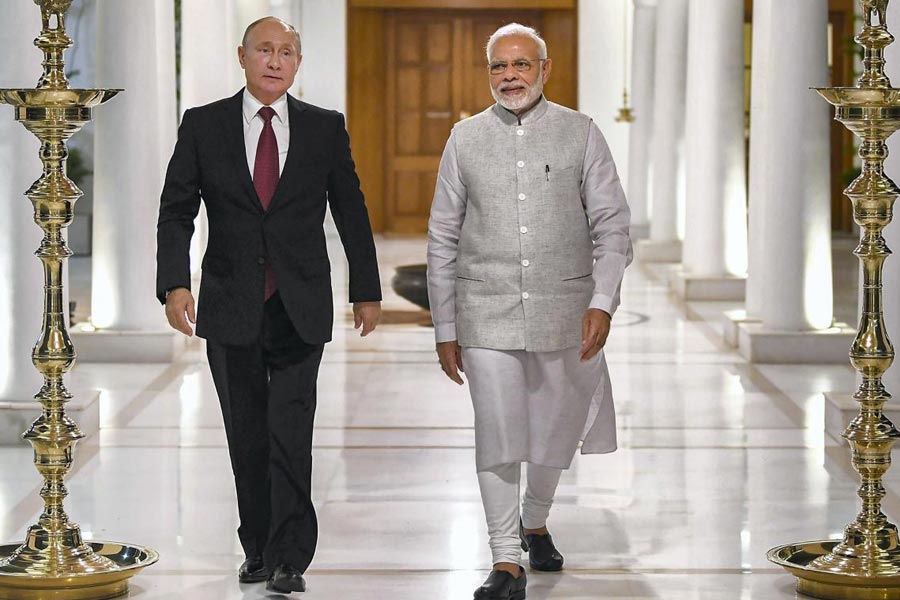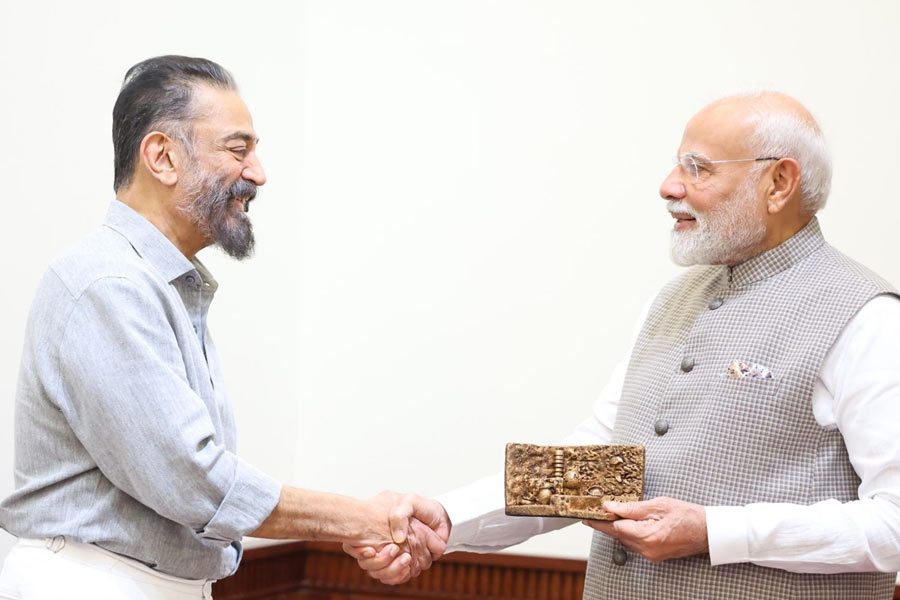-
-corr.jpg)
Rajiv and Payal Chaudhri have built a 'museum quality' collection that includes gems like F. N. Souza's Man and Woman (below) and G.R. Santosh's oil on canvas and have also been avidly promoting Indian art
A distinctive Raza, stunning Souzas and a huge Bal Chhabda painting greet visitors as they step into the spacious entranceway of Umesh and Sunanda Gaur's palatial home in New Jersey. But this sensory overload is only a teaser. For below, room after room is filled with art.
It's called the Bindu Modern Gallery and the Gaurs, who are among the largest collectors of Indian art in the United States, have created it in 4,000sqft of their 14,000sqft home. Over the last two years, their gallery has become the centre of efforts by the couple — he owns Gaur Asset Management while she specialises in paediatric AIDS — to promote Indian art in the US.
On view currently, for instance, is an exhibition on Recent Indigenous Art of India. And among the 50 masterpieces are a stunning Gond work by the legendary Jangarh Singh Shyam and a Mithila painting by the pioneering Sita Devi. 'We want to promote Indian art at the local, state and national level,' says Gaur, who's progressed from collecting Modern Indian to tribal art to photography.
-
.jpg)
Image courtesy Rajiv and Payal Chaudhri
Meanwhile, across at the prestigious Art Institute of Chicago, collectors Prabhakant Sinha, chairman and co-founder of consultancy ZS Associates, and his wife, Anita, are still riding high on the success of the recent retrospective on Indian artist Zarina Hashmi. Sinha is the first Asian American trustee at the Art Institute. And over the last two years, he has financially supported shows like Hashmi's and also worked hard to raise funds for the museum's South Asian art department, expand its reach and draw in the Indian community.
When the Indian art market boomed in the mid-2000s, it put the spotlight on a host of non-resident Indians (NRI) who emerged as among the biggest collectors of Indian art. Now over the last few years, these collectors have quietly turned into patrons of art, promoting and funding Indian art across the US.
'NRI art collectors have played a very important role in promoting and patronising Indian art,' says Vadehra Art Gallery's Arun Vadehra.
-

Image courtesy Rajiv and Payal Chaudhri
Take a look at Rajiv Chaudhri, the hedge fund manager who first made a splash when he bought Tyeb Mehta's Mahisasura for a record $1.6bn in 2005 in New York. He and his wife Payal have built an over-200-strong 'museum quality collection' of ancient and Modern Indian art that includes masterpieces by everyone from F.N. Souza to G.R. Santosh. And they're as keen to share this with a wider audience and spread 'knowledge of Indian art and artists'.
'We believe that an appreciation of art is both a source of private joy and a public virtue,' says Chaudhri. He's not looking at educating Westerners alone. 'Equally important but far more challenging is educating the Indian of today on the value of art and aesthetics,' he says. So he annually allocates 'over-six-figure sums' to museums, exhibitions and art events and has committed 'multiple millions of dollars' over the years.
Or take a look at radiation oncologist and prominent Democrat Mahinder Tak, 66, in Washington DC. She began collecting Indian art back in the 1980s, even promoting top artists like M.F. Husain and Manjit Bawa. She's said to have one of the largest collections of 300 works. But she's moved beyond it to becoming a trustee of the National Museum of Women in the Arts in DC.
-
.jpg)
Prabhakant Sinha, who is the first Asian American trustee of the Art Institute of Chicago, and his wife Anita co-chaired a Diwali gala (below) at the museum recently to raise funds
Then, there are others like tech entrepreneurs Dipti and Rakesh Mathur (he's the brain behind Junglee and Webaroo), who are on the boards of institutions like the San Jose Museum of Art.
-
.jpg)
Image courtesy Prabhakant and Anita Sinha
'It's still a young phenomenon. Most Indians are still buying art to decorate their homes or because they've heard it's a quick way to make money. And there are only a few collectors who are thinking beyond that,' says Madhuvanti Ghose, Alsdorf Associate Curator of Indian, Southeast Asian, Himalayan and Islamic Art at the Art Institute of Chicago.
However, Anuradha Ghosh-Mazumdar, head of the department of Indian & Southeast Asian Art at Sotheby's, New York, believes that 'many US- and UK-based NRI collectors' have emerged as 'institutional patrons and supporters' in the last 15 years.
-
.jpg)
Mahinder Tak (right), seen here with artist Zarina Hashmi, is among the earliest NRI art collectors
So just as pioneering collectors like Kiran Nadar, Anupam Poddar and Rajiv Savara are supporting the arts back home, their NRI counterparts have taken a lead in the US. They're eager to share their collections in the public realm. 'It's a natural evolution in the process of collecting,' says Ghosh-Mazumdar.
They're also driven by a desire to connect with their Indian heritage. 'I felt this [collecting] was a way of passing on our culture to my children,' says Tak. And they're also inspired by American-style philanthropy. Some, like the Sinhas, who have donated over $300,000 to the Art Institute, are being encouraged by proactive curators like Ghose.
As art patrons, the NRI collectors are collaborating with museums, funding exhibitions and lending their collections. In 2009-10, for instance, the Chaudhris supported Bharat Ratna: Jewels of Modern Indian Art, the first exhibition of Modern Indian art at the Museum of Fine Arts, Boston. It was based on 16 gems from their collection like Souza's haunting Man and Woman. More recently, they've funded and lent works to the Hashmi retrospective and also to the first show on Gaitonde at the Guggenheim that's scheduled in 2014.
-
.jpg)
A Husain work from her collection. Image courtesy Mahinder Tak
The Gaurs too have initiated at least three major museum exhibitions including India: Contemporary Art from Northeastern Private Collections at the Zimmerli Art Museum in 2003 and an Indian photography exhibition at Newark Museum in 2007. Now at Bindu Modern, apart from curated exhibitions, they're hosting 15 events a year including lectures and visits by museum curators.
The NRI collectors are also getting onto the acquisition committees and boards of museums (just as Indian collectors like Savara and Czaee Shah). For instance, Payal is on the board of the Guggenheim International Directors Council. And Gaur is on Peabody Essex Museum's overseer board.
The museums too are wooing them. At the Art Institute, Ghose brought in Sinha as trustee. She joined the Institute after an endowment from collector Marilyn Alsdorf led to the creation of the Alsdorf Galleries in 2007. 'I came here without knowing a single person,' she says. So she reached out to Indian Americans and found in Sinha her ideal trustee.
For the Sinhas too, the timing was right as their children had moved to college and he was also reducing his work commitments. 'We had the time and resources and the interest,' says Sinha. Although the two only got into art in the late 1990s, when a close friend encouraged them to attend a Sotheby's auction, they've built an eclectic collection that includes Modern Indian, Japanese and Cambodian art. But their major focus is on Indian antiquities.
-
.jpg)
Sunanda and Umesh Gaur are raising awareness of Indian art through exhibitions at their Bindu Modern Gallery (below)
One hallway of their Chicago apartment comprises a statuary gallery. The pride of place here goes to a double-sided Buddha from the Kushan period. Yet another favourite is a rare 18th-century fabric from the Coromandel coast depicting the battle of The Ramayana. 'There are only 10-15 of these left,' he says.
'We'd like to raise awareness about Indian art in Chicago as people know nothing about it,' says Anita. So, Sinha has helped Ghose to strategise and execute activities for her department. Last year they formed a collectors' group. The Sinhas also co-chaired their third Diwali gala recently. 'This gives me a substantial kitty for my activities,' says Ghose.
Unlike the Sinhas, Chaudhri became an art lover early in life. He quips that he must have been 'born with a mutant aesthetic gene' because nobody in his family was interested in art. Yet, at age 10, he began buying posters from the NGMA, Delhi, besides 'spending large amounts of time and money' on reading and buying books on art in the 1970s. Later, when he moved to Harvard and then to work in New York, their museums became his 'aesthetic temples'.
And when 'fortuitous circumstances' allowed him to start buying, he knew that 'my collection had to be about India, everything Indian and only Indian'. 'I wanted to be a leader in inspiring new patterns of thought and behaviour in the realm of aesthetics among my fellow countrymen. And as a denizen of art-obsessed New York, I wanted to project Indian art here,' he says.
He began collecting both antiquities and Modern Indian art. Two favourites are sculptures of an archer and a celestial goddess from the medieval period. He's also chosen quality over quantity. 'We want to own works done by geniuses in their finest moments,' he says.
The desire to promote India's heritage has also impelled Tak, who traces her love for art to her childhood in Kashmir, where she'd watch summer art camps in Gulmarg. Later, she visited galleries while studying in Delhi. Still, it was only after she met Husain in the US in the early 1980s that she began collecting. 'Husain taught me all about art,' she says. He also introduced her to Chester Herwitz, the big American collector of Indian art. 'I saw his collection and said, 'Why can't an Indian do this',' recalls Tak. So she began visiting artists' studios and galleries in India through the 1980s and 1990s.
-
.jpg)
Image courtesy Art Institute of Chicago
And she also began introducing Americans and first-generation Indians to Indian art, even promoting artists from Husain to Arpana Caur when they visited the US. 'It became a passion for me. I felt the world should see this wonderful Indian heritage,' she says. She's supported and lent her works to various museums over the years. For instance, she was on the board of the Smithsonian's Freer & Sackler Galleries.
Now, her 'engagement' has 'widened beyond Indian art'. But she's also looking at donating her collection to a museum eventually. 'That will take five to six years,' she says.
Meanwhile, the Gaurs have already created their own museum with the Bindu Modern. 'We're privileged to own these works, but that doesn't mean we shouldn't share them,' he says.
Gaur's interest in art actually began after he went to the US for a PhD in the 1970s and found that unlike him, his fellow students were very 'savvy about art'. So he started collecting art posters before moving on to visiting museums to see the originals. By the early 1980s, he wanted to own some paintings. But he had little idea of the price of masters like Picasso till a visit to a Soho gallery 'shattered' his dream. That's till he stumbled upon Indian art on a trip to India in the mid-1980s, when he saw a 'bearded man' dashing off autographs at Volga restaurant in Delhi. 'My brother told me he was M.F. Husain and that he'd showed with Picasso. That's when I realised I could probably afford Indian art,' says Gaur.
Naturally, his first painting was a Husain. Soon he and his wife began buying works by all the leading Moderns, primarily at auctions. 'We've always concentrated on well-established artists,' he says. One favourite is Ram Kumar and also Mehta's Diagonal series. He was also the first to buy Subodh Gupta and T. V. Santhosh paintings outside India.
Since 2002, the Gaurs have been promoting Indian art by supporting exhibitions and museums. Now, at the Bindu Modern, he's working on his next exhibition, on photography, slated for 2015-16 — he's already collected over 40 works by everyone from Raghu Rai to Vivek Vilasini.
The Art Institute's Ghose believes that it's time we stopped expecting Westerners to support Indian art and culture. 'If you want to see Indian art and if you want awareness of it to grow, you have to get Indians to support it,' she says. Clearly, the leading NRI collectors have dealt the first brush strokes on that canvas.

-corr.jpg)

